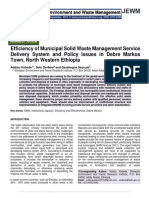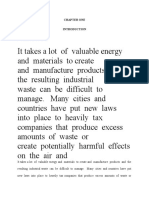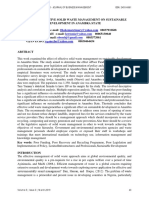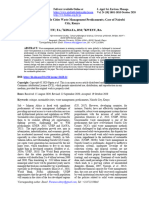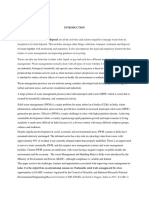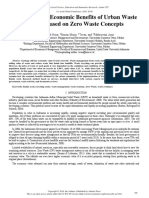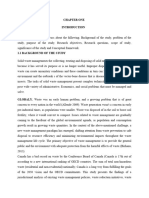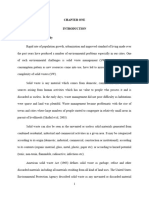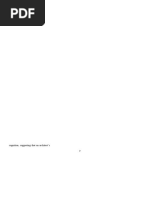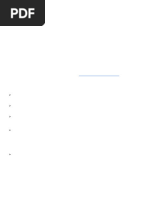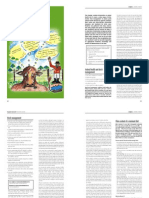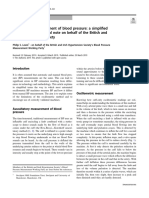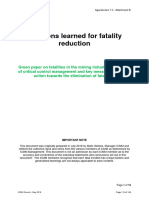Exploring The People's Perception and Attitude Towards Solid Waste Management in Commercial Area A Case of Sango, Ogun State Nigeria
Exploring The People's Perception and Attitude Towards Solid Waste Management in Commercial Area A Case of Sango, Ogun State Nigeria
Copyright:
Available Formats
Exploring The People's Perception and Attitude Towards Solid Waste Management in Commercial Area A Case of Sango, Ogun State Nigeria
Exploring The People's Perception and Attitude Towards Solid Waste Management in Commercial Area A Case of Sango, Ogun State Nigeria
Original Title
Copyright
Available Formats
Share this document
Did you find this document useful?
Is this content inappropriate?
Copyright:
Available Formats
Exploring The People's Perception and Attitude Towards Solid Waste Management in Commercial Area A Case of Sango, Ogun State Nigeria
Exploring The People's Perception and Attitude Towards Solid Waste Management in Commercial Area A Case of Sango, Ogun State Nigeria
Copyright:
Available Formats
Volume 7, Issue 12, December – 2022 International Journal of Innovative Science and Research Technology
ISSN No:-2456-2165
Exploring the People’s Perception and Attitude
towards Solid Waste Management in Commercial
Area: A Case of Sango, Ogun State Nigeria
Onukogu Humphrey Franciscoa, Mohd Rusli Yacob*a Abdullahi Adamub,
a b
Department of Environmental Studies, Department of Environmental and Resource Management,
Faculty of Forestry and Environment Universiti Putra Faculty of Engineering and Environmental Design,
Malaysia (UPM) Serdang, Selangor D.E Malaysıa Usmanu Danfodiyo University Sokoto, Nigeria
Abstract:- Commercial areas are among the key places expenditure needed to provide the service, the absence of
in municipalities that generate quite ample amount of financial support, limited resources, the unwillingness of the
solid waste of various kindsmajorly due to inefficient users to pay for the service and lack of proper use of
waste managementsystems.However, public economic instruments have hampered the delivery of proper
participation has a direct bearing on efficient solid waste waste management services.According to Nathanson,
management andthus, peoples’ perception and attitude (2017), The tasks of solid waste management present
towards solid waste have significant influence on success complex technical challenges. They pose a wide variety of
of the solid waste management system. The objective of administrative, economic, and social problems that must be
the present study is to explore the peoples’ attitude and managed and solved.
perception towards solid waste in commercial area of
Sango, Ogun State, Nigeria.A survey wasemployed on Waste management practices especially the municipal
200 randomly selected vendorsfromcommercial areas of solid waste differ for developed and developing nations,
Sangousing a self-administered, validated questionnaire urban and rural areas, and for residential, commercial and
as the research instrument. The data was analyses with industrial centers. Failure to provide basic waste
the aid of statistical pages (SPSSv23 and MS Excel) using management facility makes citizens to dump waste on the
both descriptive statistics and interferential (Pearson streets, open spaces, drains, and water bodies near their
Correlation). The result of the study shows that the vicinity creating unhygienic and insanitary
respondents have shown high level of positive perception conditions(Kumar & Nandini, 2013).Commercial areas are
and attitude towards solid waste management in the characterized with the production of high amount of waste
commercial area. More so, age has the strongest of various categories. About 10-30% of waste produced in
relationship with attitude towards solid waste developing countries are generated from the commercial
management while level of education has the strongest areas (Nabegu, 2010). Waste generated from these areas are
relationship with their perception about the solid waste quite heterogeneous in nature making them difficult to be
management.Based on the study result, it can be utilized as raw materials (Valkenburg et al., 2008).
concluded that attitude and perception about solid waste
management is positively related with age and level of In Nigeria, solid waste generation ranges from 0.44 to
education. Thus, it can be recommended that efforts 0.66 kg per capita per day and up to 25 million tons per
should be geared towards bringing people into solid annum, with household and commercial areas contributing
waste management in public places such as commercial about 10% of total urban waste burden(Estate & Iweka,
areas in order to tap from the benefit of the positive 2009). Municipal waste density in the Country falls within
perception and good attitudes they held towards waste the range 280 to 370 kg/m (Zhang, Tan, & Gersberg, 2010).
management. Reports have shown that roughlytwo thirds of these wastes
are dumped indiscriminately on the streets and in the drains
Keywords:- Attitude, Commercial area,Nigeria, Perception, thus posing serious environmental health
Solid waste. hazards(Emelumadu, Azubike, Nnebue, & Fazubike, 2016).
I. INTRODUCTION The perception of one’s capability is said to set a limit
to what to do and ultimately what can be achieved. The
Population explosion, booming economy, rapid influence of perception which describes how a person views
urbanization and the rise in community living standards himself and the world around him and how it tends to
have greatly accelerated the municipal solid waste govern behavior is explained by Anomie
generation rate in developing countries(Guerrero, Maas, & theory,(1968).Community participation has a direct bearing
Hogland, 2013). Municipalities, usually responsible for on efficient Solid Waste Management. In this sense,
waste management in the cities face the challenges of individual’s perception will influence the cultural values,
providing effective and efficient system to the inhabitants. responses, and success of the solid waste management
Moreover, they often face problems beyond their ability to system. Thus, perception on waste management services is
mainly due to lack of organization, financial resources, important for achieving safe, clean and healthy environment
complexity and system multi dimensionality (Ezebilo, (Kumar & Nandini, 2013).According to Longe, Longe, &
2013). Due to financial resources for instance, the huge Ukpebor, (2009), people’s perception on solid waste
IJISRT22DEC909 www.ijisrt.com 1276
Volume 7, Issue 12, December – 2022 International Journal of Innovative Science and Research Technology
ISSN No:-2456-2165
management system is characterized with irregularity and collection methods, insufficient coverage of the collection
inefficient collection system; with poor monitoring of the system and improper disposal of solid waste.
private waste service providers by the local authority. In the
study by Bom, Belbase, & Bibriven Lila, (2017),their The main sources of municipal solid waste are from
findings shows that more than 80% of surveyed respondents domestic areas, commercial centers, food stores, slaughter
indicated that environmental perception and concern was the areas, warehouses and institutional premises (Fronti & Poor,
major motivation to recycling of waste material. 1994). Study by Magutu & Onsongo, (2010), showed thatthe
major sources of MSW are foodwastes, paper, plastic, rags,
More so, Nabegu, (2010), found that attitudes have metal and glass, with some hazardous household waste, such
been positively influenced through awareness-building as; electric light bulbs, batteries, discarded medicines and
campaigns on the negative impacts of inadequate waste automotive parts. MSW is thus seenas primarily coming
collection with regard to public health and environmental from households and commercial areas.It also comprise of
conditions, and the value of effective disposal.Haider, wastes from offices, hotels,shopping complexes/shops,
Amber, Ammara, Mahrukh, & Aisha, (2015), on their part, schools, institutions, and from municipal services such as
have explained that people’s attitudes varied based with streetcleaning and maintenance of recreational areas. In
respect to waste storage and segregation, placement and some countries the solid wastesmanagement system also
collection of solid waste and regarding reuse of old items. handles human wastes such as night-soil, ashes from
They further observed that perception of males and females incinerators,septic tank sludge and sludge from sewage
about disposal of solid waste varied and males were seen to treatment plants. The complexities and enormityof the
be more concerned with segregation and recycling than challenges become evident when considering other waste
females. In this regards, the present work is set within the types to be managed andthese include industrial solid waste,
effective municipal solid waste management framework, municipal wastewater, industrial wastewater, stormwater
especially as it focuses on investigating the stakeholders’ and hazardous waste.
perception andattitudetowardssolid waste management
system. Commercial waste consists of those types of wastes
generated from business premises.The composition of waste
II. LITERATURE from these areas are usually food waste, yard waste, wood,
plastics, papers, metals, leather,rubbers, inert materials,
The increase in population, urbanization and batteries, paint containers, textiles, constructionand
industrialization including globalization, has led to the demolishing materials and many others which would be
challenge of solid waste management (SWM) in many difficult to classify (Miezah, Obiri-danso, Kádár, Fei-baffoe,
countries and made it even more complex(Nkansah, Dafor, & Mensah, 2015).
& Essel-Gaisey, 2015). This is attributed to inadequate
regulatory framework that has manifestedin lack of interest III. METHODOLOGY
of private sector investment in service delivery,
uncoordinatedinstitutional functions, low political will, low A. Study Area
capacity to discharges duties, poor data information Sango Ota, the local government headquarters of Ado-
forplanning, andpoor attitude of waste generator (Tobore, Odo/Ota is the most populated among the 20 LGAs in Ogun
2014).These challenges have resulted in health related State, South Western Nigeria (Fig 3.1). The city has an
problems, loss of properties as a result of choked gutters, estimated population of about six hundred and sixty nine
indiscriminate waste disposal and uncollected refuse in thousand, eight hundred and eighty six hundred
communal waste containers. These wastes eventually find (669,886)people based, with a growth rate of 3.5%). The
themselves in water bodies destroying the city is located on longitude 30 14’ 32”Eand latitude60 42’
ecosystem(Nkansah et al., 2015). 19” N, and it is one of the industrial hubs with the highest
concentrations of industries in Nigeria. It accommodates
According to Ogwueleka, (2009), the volume of solid several hundred industries which include food, beverages
waste generated continues to increase at a faster rate than and tobacco; pulp and paper products; chemical and
the ability of the agencies to improve on the financial and pharmaceuticals; metallurgy; gas; plastics; wood processing;
technical resources needed to curb thesituation. Solid waste and non-metallic mineral products (Omole, Emenike,
management has emerged as one of the greatest challenges Tenebe, Akinde, & Badejo, 2015). The proximity of Sango
facing state and local government environmental protection Ota to Lagos especially border town of Idiroko has led to the
agencies in Nigeria (Tobore, 2014). Solid waste creation of two larger markets namely; the Kayero market
management in Nigeria is characterized by inefficient and Oba T.T Dada market, which later fused together and
are commonly referred to as the Sango Ota market.
IJISRT22DEC909 www.ijisrt.com 1277
Volume 7, Issue 12, December – 2022 International Journal of Innovative Science and Research Technology
ISSN No:-2456-2165
Fig. 1: Map of Nigeria (A) showing Ogun State (B) and Sango Ota (C)
B. Population and Sampling IV. RESULT AND DISCUSSION
The population of the study comprised of the shop/
business premises owners in the commercial area of Sango A. Socio-Economic Characteristics
Ota. Based on available data from the local authorities on The socio economic profile of the respondent as
business premises that are paying tax to the government, presented on Table 1 shows that based on gender
there are 1730 business premises in the commercial area distribution, male were 77.5% while female were 22.5%. On
which formed the study population. As Chuan, (2006) stated respondents’ age, it ranges between 18 and over 56 years
that many studies are conducted using Cohen’s (1988) old, with mean age =35 years. Those whose age were 18-25
statistical power analysis as the guideline for estimating the years old were 23.0% while the older respondents (56 years
desired sample size, the sample size used in this study was and above) were 8.0%. In terms of education level, it was
determined based on the Cohen formula. According to found that 24.5% have reported to have never been to
Chuan, (2006), using Cohen formula, sample size of 120 is school, 20.5% attended only primary, 40% secondary school
sufficient enough to answer research objectives using, both, while the remaining 15.0% had reported to have university
correlation analysis and multiple regression analysis. Thus degree. About ownership of the business premises, only
this study adopted this sample size and increased it to round 24.5% were the actual owners of the shop while the
number (200) in order to take care of missing values.Lastly, remaining 74.5% were only shop attendants.
this study employed simple random sampling technique to
distribute the 200 samples from the total list of shop owners/ On marital status, those who were married were 66.5%,
business premises within the commercial area. single were 25.0%, divorced were 5.5%and widows 3.0%.
Percentage of respondent based on business type shows
Data collection was carried on the selected cosmetics has 21.0%, food items 37.0%, electronics 28.5%,
respondents using questionnaire admiration. The fruits and juice 11.0% and others were 2.5%. Moreover,
questionnaire was in Likert scale and multi-category format, gross monthly income of the respondents was obtained as
which were distributed to the respondents after seeking for those with income within the range of 10,000-20,000 were
their consent to participate in the survey. The answered 43.5%, 21,000-30,000 income bracket were 30%, while
questionnaires were collected back and analyses with the aid those who earn 31,000-40,000 were 20.5%. Only 4.5% earn
of a computer software package (SPSS version 23). between 41,000-50,000, while those who earn between
51,000 above constituted only 1.5%.
IJISRT22DEC909 www.ijisrt.com 1278
Volume 7, Issue 12, December – 2022 International Journal of Innovative Science and Research Technology
ISSN No:-2456-2165
Element (n=200) Mean Freq. Percentage (%)
Gender
Female 45 22.5
Male 155 77.5
Age 35.80
18-25years 46 23.0
26-35 years 53 26.5
36-45 years 59 29.5
46-55years 26 13.0
56 years above 16 8.0
Shop Ownership
Not owner 151 75.5
Owned 49 24.5
Educational level
Never been to school 49 24.5
Primary 41 20.5
Secondary 80 40.0
Tertiary 30 15.0
Marital Status
Married 133 66.5
Single 50 25.0
Widow 6 3.0
Divorce 11 5.5
Business Type
Cosmetics 42 21.0
Food items 74 37.0
Electronics 57 28.5
Fruits and Juices 22 11.0
Others 5 2.5
Gross monthly income (Naira) 23644.5
10,000-20,000 87 43.5
21,000-30,000 60 30.0
31,000-40,000 41 20.5
41,000-50,000 9 4.5
51,000 above 3 1.5
Table 1: Socio-Economic Characteristics of the Respondents
B. The Respondents Perception towards Solid waste were undecided. Those who disagree were 6.5% whereas
Management service in the Market those who strongly disagree were just 1.0%.
The respondent perception about solid waste
management in the market premises was measured on 5- “I will support any government’s decision and plan to
point likert scale and the result is presented in percentage in engage private sector participation in solid waste collection
Table 2. The responses obtained indicate that the services” was the statement that 25.5% of the respondents
respondents have shown high level of positive perception strongly agree with it, 35.0% agreed while 31.5% remained
about solid waste management and handling in the undecided. However, only 5.0% disagree and 3.0% strongly
commercial area of Sango, Ogun State. The statement that disagree with the statement.
“Solid waste management service is not handled effectively
and efficiently in this commercial centre”, majority of the More so, on the statement that said “I am interested in
respondents (42%) strongly agree, and 30% agree, whereas improvement in solid waste management in our
only 2.5% disagree and 3.5% strongly disagree. However, neighborhood”, 33.5% strongly agreed with it, 35.5% agreed
those who remain neutral about the statement were 16.5%. while 4.5% disagree and 2.0% strongly disagree with the
statement. Only 24.5% remained neutral about the
When respondents were asked that Government should statement. Again, when respondents were presented with
only partake in the contracting process of private solid waste the statement that said “I am satisfied with the overall solid
service providers, majority of the respondents (45%) waste management in this area”, majority of the responding
strongly agree with the statement, 35.5% agreed, and 13.0% (33.0%) strongly agree with the statement, 31.0% agree,
remain neutral. However, 1.0% strongly disagrees while whereas 29.5 were undecided. However, only 4.0% disagree
5.0% disagrees. The responses on Poor solid waste and 22.5% strongly disagree with the statement.
management causes environmental deterioration in our
business premises show mixed result. About 27.5 strongly
agree with the statement, 37.5% agreed, while 37.5% again
IJISRT22DEC909 www.ijisrt.com 1279
Volume 7, Issue 12, December – 2022 International Journal of Innovative Science and Research Technology
ISSN No:-2456-2165
For the last statement used on measuring the 35.5% agreeing. For those who disagree, they constituted
respondents’ perception (I am willing to pay more for 6.5%, those who strongly disagree were 1.5% whereas
services that will enhance environmental quality), majority 18.5% remain neutral.
of them (38.0%) strongly agree with the statement and
PERCEPTION Mean 1 2 3 4 5
(%)
1 Solid waste management services is not handled effectively and efficiently in this 4.11 3.5 2.5 16.5 30.0 42.5
commercial centre
2 Government should only partake in the contracting process of private solid waste 4.20 1.0 5.0 13.0 35.5 45.5
service providers
3 Poor solid waste management causes environmental deterioration in our business 3.84 1.0 6.5 27.5 37.5 27.5
premises
4 I will support any government’s decision and plan to engage private sector 3.75 3.0 5.0 31.5 35.0 25.5
participation in solid waste collection services
5 I am interested in improvement in solid waste management in our neighbourhood 3.94 2.0 4.5 24.5 35.5 33.5
6 I am satisfied with the overall solid waste management in this area 3.88 2.5 4.0 29.5 31.0 33.0
7 I am willing to pay more for services that will enhance environmental quality 4.02 1.5 6.5 18.5 35.5 38.0
Table 2: Perception about Solid waste Management service
Note: 1=Strongly agree, 2=disagree, 3=Neutral, 4=Agree, 5=Strongly agree
In other to investigate the overall respondents’ level of second category that revealed a moderate level of perception
perception, composite score of the 8 items measuring the were 32.0%. However, only 8.0% out of the total valid
‘perception’ construct was determined. The overall score for responses obtained shows low level of perception towards
the items were categorized in to 3 groups namely; low, solid waste management. With this outcome, it can be
moderate and high perception based on individual total presume that majority of the respondents in the commercial
score. The frequency distributions and percentage of each area of Sango had a high perception towards solid waste
category is shown in Table 2. The result shows that more management and therefore, indicates the likelihood of their
than half of the respondents (60.0%) had indicated a high willingness to support solid waste management program that
level of perception towards solid waste management. The will aimed at reducing waste in the market.
120
120
100
80 64
60.0
60
40 32.0
16
20 8.0
0
Low Perception Moderate High Perception
Perception
Frequency 16 64 120
Per cent 8.0 32.0 60.0
Fig. 2: Respondents’ Level of perception towards Solid waste Management
IJISRT22DEC909 www.ijisrt.com 1280
Volume 7, Issue 12, December – 2022 International Journal of Innovative Science and Research Technology
ISSN No:-2456-2165
C. Respondents Attitude Towards solid Waste management neutral. On the other hand, 3.5% disagree with the
in the Market statement, whereas 1.5% strongly disagrees.
Respondents’ attitude towards solid waste management
in the commercial area of Sango, in Ogun state Nigeria was “I really want to see our business premises is clean for
explore using 10 items measured on a 5-point likert scale. people to live there healthy and happily” is the statement
The result (Table 3) shows that majority of the respondents that majority of the respondents (44.5%) strongly agree with
have responded positively to the statement, which indicates it, and 43.0% also agree while 4.5% disagree and 1.0%
a positive view that translates into a positive attitude strongly disagree with it. Only 7.0% were undecided. In
towards the solid waste management in the area. addition, the statement that says “I so much have passion for
environmental quality improvement, especially as it relates
For the first item used in measuring the respondent’s to SWM” had 43.5% strongly agree response and 45.0%
attitude, it states that “Monthly environmental sanitation agree. About 8.0% were neutral while 2.5% disagree and
exercise has impact on environmental pollution reduction in 1.0% strongly disagreeing with the statement. More than
our neighborhood”. About 22.0% strongly agree with the half of the respondents (52.0%) agree to the statement that
statement, 44.5% agree and 16.0 were neutral. Those who “I have never heard anything about private solid waste
disagree were 9.5% and the remaining 8.0% strongly service providers” and 32.5% even strongly agree with the
disagree with the statement. The second item stated that statement. But for those who held negative view about the
“SWM issues are included in my priorities and thus, willing statement, 4.5% disagree, 2.5% strongly disagree and 8.5%
to take part in environmental quality improvement” and were undecided.
those among the respondents that strongly agree with it were
30.0%. Majority of the respondents (50.0%) also agree, About the statement that says “I get disturbed seeing
while 13.0% were undecided. However, Only 4.5% disagree my environment in a dirty condition everyday”, 38.5%
and 2.5% strongly disagree with the statement. strongly disagree with the statement and 47.0% agree, while
7.5% were neutral. Those who disagree were 4.0% and
For the statement “Government’s policy on SWM in those who strongly disagree with the statement were 3.0%.
commercial areas has open up new avenues for us on SWM The last item used in measuring the respondent’s attitude is
services”, about 39.5% strongly agree, 42.5% agree while the statement that says “I cherished clean and tidy
5.0% disagree and 1.5% strongly disagree. However, only environment because I have concern for the future
11.5% remained undecided. More so,the statement “SWM generation”. Majority (46.5%) voted strongly agree to the
issues are important for the economic and societal statement and 45.5% agree while 3.0% were neutral. About
development” has 38.0% response as strongly agree. 45.5% 4.0% disagree and 1.0% strongly disagrees with the
agree, 12.5% were neutral whereas 3.0% disagree and 1.0% statement. To make conclusion about the general
strongly disagrees. From the responses, about12.5% respondents view with regards to the items measuring
remains undecided. For the statement “I am ready to accept attitudes towards solid waste management, the study
any new policy on SWM in which would improve quality of outcome have portrayed that majority of the respondents in
the environment”, 35.5% strongly agree with the statement, the study area held a more positive attitude towards the solid
Majority of them (50.5%) also agree while 9.0% were waste management in the commercial area of Sango, in
Ogun state
ATTITUDE Mean 1 2 3 4 5
(%)
1 Monthly environmental sanitation exercise has impact on environmental 3.63 8.0 9.5 16.0 44.5 22.0
pollution reduction in our neighborhood.
2 SWM issues are included in my priorities and thus, willing to take part 4.01 2.5 4.5 13.0 50.0 30.0
in environmental quality improvement
3 Government’s policy on SWM in commercial areas has open up new 4.12 1.5 5.0 11.5 42.5 39.5
avenues for us on SWM services
4 SWM issues are important for the economic and societal development 4.17 1.0 3.0 12.5 45.5 38.0
5 I am ready to accept any new policy on SWM in the that would improve 4.15 1.5 3.5 9.0 50.0 35.5
quality of the environment
6 I really want to see our business premises is clean for people to live 4.26 1.0 4.5 7.0 43.0 44.5
there healthy and happily
7 I so much have passion for environmental quality improvement, 4.28 1.0 2.5 8.0 45.0 43.5
especially as it relates to SWM
8 I have never heard anything about private solid waste service providers 4.08 2.5 4.5 8.5 52.0 32.5
9 I get disturbed seeing my environment in a dirty condition everyday 4.14 3.0 4.0 7.5 47.0 38.5
10 I cherished clean and tidy environment because I have concern for the 4.33 1.0 4.0 3.0 45.5 46.5
future generation
Table 3: Attitude Towards solid Waste management in the Market
Note: 1=Strongly agree, 2=disagree, 3=Neutral, 4=Agree, 5=Strongly agree
IJISRT22DEC909 www.ijisrt.com 1281
Volume 7, Issue 12, December – 2022 International Journal of Innovative Science and Research Technology
ISSN No:-2456-2165
The overall respondents’ level of attitude towards solid exhibiting a ‘Good’ level of attitude towards solid waste
waste management (Fig 3) was measured as an index and management. Those who exhibit ‘Moderate’ level of
categorized base on levels (Poor, Moderate and Good). The attitudes towards solid waste management constitute 15.5%,
result indicates the positive inclination of the respondents’ whereas only 4.0% shows ‘Poor’ level of attitudes.
attitude towards solid waste management, with about 80.5%
180.0 161
160.0
140.0
120.0
100.0 80.5
80.0
60.0
31
40.0 15.5
4.0 8
20.0
0.0
Poor Attitude Moderate Attitude Good Attitude
% 4.0 15.5 80.5
8 31 161
Fig. 3: Respondents’ Level of perception towards Solid waste Management
D. Correlation Analyses respondents’ income has a significant and positive
Pearson correlation was carried out in order to examine relationship with attitude towards solid waste management
the relationship between the dependent variables(attitude in the area, r= 0.511, p=.014. This shows that positive
and perception) and the independent variables (age, years of attitude towards solid waste management is positively
education and income). The result is presented in Table 4.6, related with higher income.
which shows that thedependentvariables ‘attitude and
perception’ havesignificant and positive relationship with all On the other hand, for the perception about solid waste
the independent variables. The relationship between the management in the commercial area, the study outcome
respondents’ age and attitude towards solid waste shows that it has a statistically significant relationship with
management in the commercial area of Sango was respondents’ age, r=0.363, p= .002. This also means that
statistically significant, with correlation coefficient value high perception is significantly related with higher age.
(r)=0.556(p=.000). This outcome indicated that with Years of education of the respondents also had significant
increase in age, the attitude towards solid waste and positive relationship with perception, r=0.471, p=.000.
management also increases among respondents in the study This result indicated that the more the years spent on
area. For the relationship between respondents’ years of education by the respondent, the higher his perception about
education with attitude, the result shows a statistically solid waste management in the study area.Lastly,
significant positive correlation, with r= 0.432, p=.000. This respondents’ income was also positively correlated with
result revealed that the more years someone spent acquiring perception, r=.321, p=.000. This means that higher
education, the more he will exhibit positive and good perception about solid waste management is significantly
attitude towards solid waste management.Moreover, the and positively related with high income of the respondent.
result of the correlation analyses indicated that the
Variables ATTITUDE PERCEPTION
R P-value R P-value
Age of Respondents .556 .000 .363 .002
Years of Education of Respondents .432 .000 .471 .000
Income of Respondents .511 .014 .321 .000
Table 4: Result of the Pearson Correlation
IJISRT22DEC909 www.ijisrt.com 1282
Volume 7, Issue 12, December – 2022 International Journal of Innovative Science and Research Technology
ISSN No:-2456-2165
V. CONCLUSION into solid waste management in public places such as
commercial areas in order to tap from the benefit of the
The quest for an effective solid waste management positive perception and good attitudes they held towards
policy leads to a search for a comprehensive, coordinated waste management. This will go a long way in ensuring
and governmental planning which will combine with effective management of waste in such areas. Awareness
adequate legislation, adequate fiscal provision, public campaign on the significance of solid waste management is
involvement and awareness to bring about the expected also appropriate as people will tend to change their negative
improvement in the quality of urban environment. There is ways of handling solid waste to a more scientific and
hardly any state government in Nigeria that has not shown civilized ways.
concern in the area of urban solid waste management,yet
there is no city in Nigeria that is not groaning under the REFERENCES
pressure of uncharted urban wastes. The problem has been
that the systems adopted by most cities are inadequate, [1.] Bom, U., Belbase, S., & Bibriven Lila, R. (2017).
especially for commercial areas. It is important to emphasis Public Perceptions and Practices of Solid Waste
thatmanagement needs to do more in terms of educating the Recycling in the City of Laramie in Wyoming,
people on the importance of ensuring effective waste U.S.A. Recycling, 2(3), 11.
management especially in commercial areas. http://doi.org/10.3390/recycling2030011
[2.] Chuan, C. L. (2006). Sample Size Estimation Using
A number of interesting findings emerged from this Krejcie and Morgan and Cohen Statistical Power
study.From the Results, it could be deduced that significant Analysis: A Comparison. Journal Penyelidikan IPBL,
number of the respondents have indicated good attitude and 7, 1634–1675.
high perception towards waste management in the [3.] Cohen, L., Manion, L., & Morrison, K. (2007).
commercial areaof Sango, Ogun State. About 60% indicate Research Methods in Education. Education (Vol. 55).
high level of positive perception towards waste while only http://doi.org/10.1111/j.1467-8527.2007.00388_4.x
8% indicated low level of perception.On attitude, more than [4.] Emelumadu, O. F., Azubike, O. C., Nnebue, C. C., &
80%of the respondents had indicated high level of good Fazubike, N. (2016). Practice , Pattern and
attitude towards waste management, whereas just on the Challenges of Solid Waste Management in Onitsha
opposite side, 4% of the respondents were holding negative Metropolis , Nigeria. American Journal of Public
attitude towards solid waste management in the commercial Health Research, 4(1), 16–22.
area.This outcome is partly due to the cultural practice in http://doi.org/10.12691/ajphr-4-1-3
some communities in Nigeriawhere waste management is [5.] Estate, H., & Iweka, U. (2009). Route optimization
viewed as everybody’s business but not just a government for solid waste collection : Onitsha ( Nigeria ) case
affair. As such, respondents most likely had prior experience study. Journal of Applied Science and Environmental
that assisted them to some extent in establishing and Management, 13(2), 37–40.
indicating their perception and attitude towards waste [6.] Ezebilo, E. E. (2013). Willingness to pay for
management. improved residential waste management in a
developing country. International Journal of
Based on the study findings, it is recommended that Environmental Science and Technology, 10, 413–422.
solid waste management in Nigeria should bethe matter of http://doi.org/10.1007/s13762-012-0171-2
concern for everyone.The assignment of solid waste [7.] Fronti, S., & Poor, P. (1994). Chapter 7 Solid waste
management exclusively to a single agency is not yielding management. Solid Waste Management, 105–120.
the desired result. As studies shows that no single [8.] Guerrero, A. L., Maas, G., & Hogland, W. (2013).
government agency can effectively cope with the huge Solid waste management challenges for cities in
volume of solid waste generated in most urban cities, it is developing countries. Waste Management, 33(1),
recognized that the appointment of a public agency is vital 220–232.
in urban solid waste management. It must also be http://doi.org/10.1016/j.wasman.2012.09.008
recognized that effective urban waste management demand [9.] Haider, A., Amber, A., Ammara, S., Mahrukh, K. S.,
multi-stakeholder approach in which all segments of the & Aisha, B. (2015). Knowledge , Perception and
society must be brought together in tackling the waste Attitude of common People towards Solid Waste
management issues. Management-A case study of Lahore , Pakistan, 4(3),
100–107.
Moreover, government should also make legislations [10.] Kumar, M., & Nandini, N. (2013). Community
that will establish waste management agency exclusively for attitude , perception and willingness towards solid
handling waste from commercial areas as independent waste waste management in Bangalore city , Karnataka ,
management authorities that will function like a private India. INTERNATIONAL JOURNAL OF
business corporations. This will enhance the efficiency and ENVIRONMENTAL SCIENCES, 4(1), 87–95.
effectiveness of waste management in market areas of urban http://doi.org/10.6088/ijes.2013040100009
centers. Also, government should ensure provision of [11.] Longe, E. O., Longe, O. O., & Ukpebor, E. F. (2009).
adequate funding for agencies charged with the PEOPLE ’ S PERCEPTION ON HOUSEHOLD
responsibility of solid waste management for effective SOLID WASTE MANAGEMENT IN OJO LOCAL
handling of solid waste especially in commercial areas. GOVERNMENT AREA IN NIGERIA. Iran. J.
Lastly, efforts should be geared towards bringing people Environ. Health. Sci. Eng, 6(3), 201–208.
IJISRT22DEC909 www.ijisrt.com 1283
Volume 7, Issue 12, December – 2022 International Journal of Innovative Science and Research Technology
ISSN No:-2456-2165
[12.] Magutu, P. O., & Onsongo, C. O. (2010).
Operationalising Municipal Solid Waste
Management.
[13.] Miezah, K., Obiri-danso, K., Kádár, Z., Fei-baffoe,
B., & Mensah, M. Y. (2015). Municipal solid waste
characterization and quantification as a measure
towards effective waste management in Ghana. Waste
Management, 46(2015), 15–27.
http://doi.org/10.1016/j.wasman.2015.09.009
[14.] Nabegu, A. B. (2010). An Analysis of Municipal
Solid Waste in Kano Metropolis, Nigeria. Journal of
Human Ecology, 31(2), 111–119.
[15.] Nathanson, J. A. (2017). Solid-Waste Management.
In Encyclopædia Britannica, inc. Encyclopædia
Britannica, inc.
[16.] Nkansah, E., Dafor, N. K., & Essel-Gaisey, F. (2015).
Willingness to pay for improved solid waste disposal
in Tema metropolis Ghana. UDS International
Journal of Development, 2(1), 116–127.
[17.] Ogwueleka, T. C. (2009). Municipal solid waste
characteristics and management in Nigeria. Iranian
Journal of Environmental Health Science &
Engineering, 6(3), 173–180.
http://doi.org/10.1016/j.wasman.2007.09.039
[18.] Omole, D. O., Emenike, C. P., Tenebe, I. T., Akinde,
A. O., & Badejo, A. A. (2015). An assessment of
water related diseases in a Nigerian community.
Research Journal of Applied Sciences, Engineering
and Technology, 10(7).
[19.] Tobore, I. E. (2014). Solid Waste Management in
Nigeria. Waste Management for Everyone, 1(1), 1–7.
[20.] Valkenburg, C., Gerber, M., Walton, C., Jones, S.,
Thompson, B., & Stevens, D. (2008). Municipal Solid
Waste (MSW) to Liquid Fuels Synthesis, Volume 1:
Availability of Feedstock and Technology (Vol. 1).
[21.] Zhang, D., Tan, S., & Gersberg, R. (2010). Municipal
solid waste management in China: status, problems
and challenges. Journal of Environmental
Management, 91(8), 1623–1633.
IJISRT22DEC909 www.ijisrt.com 1284
You might also like
- Plumbing Code Reviewer - Docx368829119Document55 pagesPlumbing Code Reviewer - Docx368829119Marc75% (4)
- GAS Testing Form - SampleDocument2 pagesGAS Testing Form - SampleMarvie Robles100% (1)
- Action Plan For Waste DisposalDocument12 pagesAction Plan For Waste DisposalLea Paquibot50% (4)
- Fight The New Drug Harmful Effects of PonographyDocument100 pagesFight The New Drug Harmful Effects of PonographySteven Gonzales100% (3)
- 6 Lahore Willingness To PayDocument10 pages6 Lahore Willingness To PayFatima KhalidNo ratings yet
- Chapter 1 To Be Submitted SoonDocument7 pagesChapter 1 To Be Submitted SoonNomsa SihlongonyaneNo ratings yet
- Solid Waste Disposal Attitude in Sango Ota, Ogun State: Implication For Sustainable City Development in NigeriaDocument8 pagesSolid Waste Disposal Attitude in Sango Ota, Ogun State: Implication For Sustainable City Development in NigeriaPremier PublishersNo ratings yet
- Revised PaperDocument44 pagesRevised PaperRose Jean PernitoNo ratings yet
- 223-430-1-SMDocument19 pages223-430-1-SMlailajamesbrownNo ratings yet
- Ethiopian Journal of Environmental Studies & Management 16 (1) : 1 - 16, 2023 ISSN:1998-0507 Submitted: December 7, 2022 Accepted: March 2, 2022Document16 pagesEthiopian Journal of Environmental Studies & Management 16 (1) : 1 - 16, 2023 ISSN:1998-0507 Submitted: December 7, 2022 Accepted: March 2, 2022wasiu akintunde YusufNo ratings yet
- Benjamin Obeng NyarkoDocument12 pagesBenjamin Obeng Nyarkosaeed ibn idrisNo ratings yet
- Effects of Poor Waste Management On Highways A Case Study of Abuja-Keffi ExpresswayDocument39 pagesEffects of Poor Waste Management On Highways A Case Study of Abuja-Keffi Expresswaycloud9digitalsNo ratings yet
- Sustainability 16 01087Document23 pagesSustainability 16 01087marilyn monferoNo ratings yet
- Ajol File Journals - 685 - Articles - 235987 - Submission - Proof - 235987 8080 570485 1 10 20221111Document9 pagesAjol File Journals - 685 - Articles - 235987 - Submission - Proof - 235987 8080 570485 1 10 20221111Musa ZiramiNo ratings yet
- Solid Waste Management Benefits To The Community Background of The StudyDocument12 pagesSolid Waste Management Benefits To The Community Background of The StudyAngel Solano100% (3)
- Characterization of Municipal Solid Waste in Yenagoa Metropolis and Its Associated Management Problems, NigeriaDocument9 pagesCharacterization of Municipal Solid Waste in Yenagoa Metropolis and Its Associated Management Problems, NigeriaIJRASETPublicationsNo ratings yet
- Muwembe Pius Research Methods Concept Paper.Document5 pagesMuwembe Pius Research Methods Concept Paper.muwembepius leviticusNo ratings yet
- Waste Management CompletedDocument6 pagesWaste Management CompletedPromise TewogbolaNo ratings yet
- Handout 3 - Module 3 Solid WastesDocument6 pagesHandout 3 - Module 3 Solid WastesKurt Bryan CortezNo ratings yet
- Effect of Waste in Urban DevelopmentDocument13 pagesEffect of Waste in Urban DevelopmentOlasupo IyaboNo ratings yet
- Efficiency of Municipal Solid Waste Management Service Delivery System and Policy Issues in Debre Markos Town, North Western EthiopiaDocument8 pagesEfficiency of Municipal Solid Waste Management Service Delivery System and Policy Issues in Debre Markos Town, North Western EthiopiaPremier PublishersNo ratings yet
- Nabukeera MadinahDocument11 pagesNabukeera MadinahPius AgyekumNo ratings yet
- Uzebueze FinalDocument45 pagesUzebueze FinalehimailnettNo ratings yet
- WASTE DISPOSAL Copy 2Document9 pagesWASTE DISPOSAL Copy 2Amin BassitNo ratings yet
- Factors Influencing Household Participation in Solid Waste Management A Case of Muhanga City, RwandaDocument12 pagesFactors Influencing Household Participation in Solid Waste Management A Case of Muhanga City, RwandaInternational Journal of Innovative Science and Research Technology100% (1)
- Challenges of Solid Waste Management inDocument14 pagesChallenges of Solid Waste Management inProsper BabrusNo ratings yet
- Application of Geographical Information System in Analysis of Suitability Refuse Dump Sites Location of Keffi Town, Nasarawa StateDocument13 pagesApplication of Geographical Information System in Analysis of Suitability Refuse Dump Sites Location of Keffi Town, Nasarawa StateInternational Organization of Scientific Research (IOSR)No ratings yet
- Recycling and Sustainable Development SoDocument8 pagesRecycling and Sustainable Development SovictoscojNo ratings yet
- Ijrdo - Journal of Business Management ISSN: 2455-6661Document14 pagesIjrdo - Journal of Business Management ISSN: 2455-6661musa jaji lawanNo ratings yet
- Larry EksuDocument20 pagesLarry EksuOMOTOSO AJEWOLENo ratings yet
- Solid Waste For FutureDocument4 pagesSolid Waste For FuturemohanrajpanchanathanrNo ratings yet
- SAAKA MUTAWAKILU THESISDocument14 pagesSAAKA MUTAWAKILU THESISsaakamutawakilu9No ratings yet
- A GIS-based Analysis For Sanitary Landfill Sites in Abuja, NigeriaDocument24 pagesA GIS-based Analysis For Sanitary Landfill Sites in Abuja, Nigeriamujahidulislam7475No ratings yet
- Adeyemi 2019 IOP Conf. Ser. Mater. Sci. Eng. 640 012108Document6 pagesAdeyemi 2019 IOP Conf. Ser. Mater. Sci. Eng. 640 012108Eletu A. A.No ratings yet
- Municipal Solid WasteDocument12 pagesMunicipal Solid WasteMagno A. GonzNo ratings yet
- Implementation of Ra9003very FinalDocument62 pagesImplementation of Ra9003very FinalJunard Hans BagnisenNo ratings yet
- Municipal Solid Waste Generation, Composition, and Management in The Douala Municipality, CameroonDocument12 pagesMunicipal Solid Waste Generation, Composition, and Management in The Douala Municipality, CameroonPremier Publishers100% (1)
- Effective Waste Management in Nigeria: The Case For SustainableDocument9 pagesEffective Waste Management in Nigeria: The Case For Sustainablemusa jaji lawanNo ratings yet
- Household Solid Waste Characteristics and Management in Chittagong, Bangladesh PDFDocument8 pagesHousehold Solid Waste Characteristics and Management in Chittagong, Bangladesh PDFSuprio Kamal100% (1)
- State of Solid Waste Management 1Document6 pagesState of Solid Waste Management 1Nick LarizaNo ratings yet
- An Analysis of Solid Waste Management Efficiency in Multiple Urban Areas: A Case StudyDocument8 pagesAn Analysis of Solid Waste Management Efficiency in Multiple Urban Areas: A Case StudyIJAR JOURNALNo ratings yet
- Garbage Classification Reserach Paper (Final)Document15 pagesGarbage Classification Reserach Paper (Final)testgupta01No ratings yet
- Ajol File Journals - 90 - Articles - 201264 - Submission - Proof - 201264 1069 504600 1 10 20201103Document10 pagesAjol File Journals - 90 - Articles - 201264 - Submission - Proof - 201264 1069 504600 1 10 20201103Garba UbaNo ratings yet
- Ibrahim Abukar Shegow and Atanga Desmond FunwieDocument10 pagesIbrahim Abukar Shegow and Atanga Desmond FunwieAwelani MphephuNo ratings yet
- Design of SWM SystemDocument20 pagesDesign of SWM SystemIshan RanganathNo ratings yet
- Waste Management DraftDocument41 pagesWaste Management DraftSnehaNo ratings yet
- Search Institute (CSIR-NEERI) and Held in Nagpur, India in 2015. SAARC IsDocument7 pagesSearch Institute (CSIR-NEERI) and Held in Nagpur, India in 2015. SAARC IsSnehaNo ratings yet
- Public Policy Analysis On Plastic Waste Control in Merauke: Review of International Geographical EducationDocument8 pagesPublic Policy Analysis On Plastic Waste Control in Merauke: Review of International Geographical EducationmelvpiranNo ratings yet
- waste mismanagement-superduperfinal-editedDocument8 pageswaste mismanagement-superduperfinal-editedyesyuff001No ratings yet
- ImmanuelDocument48 pagesImmanuelEmmanuel AbimikuNo ratings yet
- Assessment of Integrated Solid Waste Management PRDocument11 pagesAssessment of Integrated Solid Waste Management PRtewoldeNo ratings yet
- SR23623141033Document5 pagesSR23623141033cyrilinigo1504No ratings yet
- AGC206Document10 pagesAGC206wong NXNo ratings yet
- Wjarr 2023 1304Document9 pagesWjarr 2023 1304Catalina Alejandra Manquilepi RiquelmeNo ratings yet
- Activity 5.2 Online Group Discussion A2Document8 pagesActivity 5.2 Online Group Discussion A2Ahmed NasriNo ratings yet
- Waste Management Case StudyDocument7 pagesWaste Management Case Studyafmofsqsw100% (1)
- Related LiteratureDocument3 pagesRelated LiteratureBelle ReyesNo ratings yet
- 10 1080@09640568 2019 1576510Document15 pages10 1080@09640568 2019 1576510rochellealani07No ratings yet
- Chapter One and TwoDocument26 pagesChapter One and TwoMohamed Gaarane saneiNo ratings yet
- Chapter One, Two and ThreeDocument54 pagesChapter One, Two and ThreeMohamed Gaarane saneiNo ratings yet
- SALISU PROJ Community Perticipation in SolidDocument53 pagesSALISU PROJ Community Perticipation in SolidSadeeqNo ratings yet
- Solid Waste Management Program in San AntonioDocument4 pagesSolid Waste Management Program in San AntonioAna Marjorie Martinez100% (1)
- Rasos Toribio Article TypeDocument20 pagesRasos Toribio Article TypeGodwin ToribioNo ratings yet
- Developing Students’ Fluency in Speaking through the Use of the 4/3/2 TechniqueDocument3 pagesDeveloping Students’ Fluency in Speaking through the Use of the 4/3/2 TechniqueInternational Journal of Innovative Science and Research TechnologyNo ratings yet
- Cortisol as a Mediator of Oxidative Stress in Human Body CellsDocument4 pagesCortisol as a Mediator of Oxidative Stress in Human Body CellsInternational Journal of Innovative Science and Research TechnologyNo ratings yet
- Determination of Social Media, Content Marketing, and Brand Image on Purchase Intentions of KYOTO Helmet ConsumerDocument11 pagesDetermination of Social Media, Content Marketing, and Brand Image on Purchase Intentions of KYOTO Helmet ConsumerInternational Journal of Innovative Science and Research TechnologyNo ratings yet
- From Curriculum to Classroom: Teachers' Institutional Knowledge in Developing Pupils' Reading Competences through Internal Didactic TranspositionDocument13 pagesFrom Curriculum to Classroom: Teachers' Institutional Knowledge in Developing Pupils' Reading Competences through Internal Didactic TranspositionInternational Journal of Innovative Science and Research TechnologyNo ratings yet
- Artificial Intelligence Adoption in Sustainable Tourism in Sri Lanka: An Operator PerspectiveDocument15 pagesArtificial Intelligence Adoption in Sustainable Tourism in Sri Lanka: An Operator PerspectiveInternational Journal of Innovative Science and Research TechnologyNo ratings yet
- A Study to Determine Levels of Physical Activity among Health Care Professionals in Bangalore – A SurveyDocument7 pagesA Study to Determine Levels of Physical Activity among Health Care Professionals in Bangalore – A SurveyInternational Journal of Innovative Science and Research TechnologyNo ratings yet
- Development of Mobile-Based Learning Media for Supervision of Physical Education and Sports TrainingDocument10 pagesDevelopment of Mobile-Based Learning Media for Supervision of Physical Education and Sports TrainingInternational Journal of Innovative Science and Research TechnologyNo ratings yet
- A Study to Assess the Effectiveness of Clay Therapy on Physical Function among Patients with Knee Osteoarthritis in Selected Hospitals, ErodeDocument7 pagesA Study to Assess the Effectiveness of Clay Therapy on Physical Function among Patients with Knee Osteoarthritis in Selected Hospitals, ErodeInternational Journal of Innovative Science and Research TechnologyNo ratings yet
- Overcrowding of Short – Term Offenders and Remand Detained. Evidence from Pietermaritzburg-KwaZulu NatalDocument13 pagesOvercrowding of Short – Term Offenders and Remand Detained. Evidence from Pietermaritzburg-KwaZulu NatalInternational Journal of Innovative Science and Research TechnologyNo ratings yet
- Statistical Analysis of the Influence of Self Compassion on Quarter Life Crisis on Emerging Adulthood at University Alkhairaat, Palu - IndonesiaDocument6 pagesStatistical Analysis of the Influence of Self Compassion on Quarter Life Crisis on Emerging Adulthood at University Alkhairaat, Palu - IndonesiaInternational Journal of Innovative Science and Research TechnologyNo ratings yet
- Social Media Engagement and Academic Achievement among Students in Technical UniversitiesDocument15 pagesSocial Media Engagement and Academic Achievement among Students in Technical UniversitiesInternational Journal of Innovative Science and Research TechnologyNo ratings yet
- Current Outsourcing Practices Employed in Acquiring Construction Consulting Services in Tanzania: Approaches, Partnering and Services (A Qualitative Study)Document10 pagesCurrent Outsourcing Practices Employed in Acquiring Construction Consulting Services in Tanzania: Approaches, Partnering and Services (A Qualitative Study)International Journal of Innovative Science and Research TechnologyNo ratings yet
- Effects of Management Style and Work-Life Balance of Employees in Mining Companies in the Katangese Copper ArcDocument8 pagesEffects of Management Style and Work-Life Balance of Employees in Mining Companies in the Katangese Copper ArcInternational Journal of Innovative Science and Research TechnologyNo ratings yet
- Smart Object Recognition in Wireless SurveillanceDocument4 pagesSmart Object Recognition in Wireless SurveillanceInternational Journal of Innovative Science and Research TechnologyNo ratings yet
- Patient Specific ImplantsDocument6 pagesPatient Specific ImplantsInternational Journal of Innovative Science and Research TechnologyNo ratings yet
- Exploring Sense of Direction: A Comparative Study of Architecture and Fashion Design Students Using the Santa Barbara Sense of Direction ScaleDocument9 pagesExploring Sense of Direction: A Comparative Study of Architecture and Fashion Design Students Using the Santa Barbara Sense of Direction ScaleInternational Journal of Innovative Science and Research TechnologyNo ratings yet
- Work-Life Balance and Work Commitment of Employees of Mining Companies in the Katangese Copper ArcDocument9 pagesWork-Life Balance and Work Commitment of Employees of Mining Companies in the Katangese Copper ArcInternational Journal of Innovative Science and Research TechnologyNo ratings yet
- Ensuring Fair Patent Adjudication: Understanding Intellectual Property Appellate Board FrameworkDocument3 pagesEnsuring Fair Patent Adjudication: Understanding Intellectual Property Appellate Board FrameworkInternational Journal of Innovative Science and Research TechnologyNo ratings yet
- Knowledge on Self-care Management among Asthma Patients at Specialized Hospital in DhakaDocument13 pagesKnowledge on Self-care Management among Asthma Patients at Specialized Hospital in DhakaInternational Journal of Innovative Science and Research TechnologyNo ratings yet
- Enhancing Employability through Collaborative Project-Based LearningDocument10 pagesEnhancing Employability through Collaborative Project-Based LearningInternational Journal of Innovative Science and Research TechnologyNo ratings yet
- Transforming Industries through AI and Emerging Technologies: Literature Review of Opportunities, Challengers, Responsibilities, and StrategiesDocument20 pagesTransforming Industries through AI and Emerging Technologies: Literature Review of Opportunities, Challengers, Responsibilities, and StrategiesInternational Journal of Innovative Science and Research TechnologyNo ratings yet
- Determinants of Low Birth Weight Prevalence Among Children Born between May 2024 and October 2024, (in Leer County, Unity State, South Sudan.)Document31 pagesDeterminants of Low Birth Weight Prevalence Among Children Born between May 2024 and October 2024, (in Leer County, Unity State, South Sudan.)International Journal of Innovative Science and Research TechnologyNo ratings yet
- The Art of Taming AI and Digital Tools in the FLEND (Flip / Blend Integrated) ClassDocument7 pagesThe Art of Taming AI and Digital Tools in the FLEND (Flip / Blend Integrated) ClassInternational Journal of Innovative Science and Research TechnologyNo ratings yet
- Serum Albumin Levels: A Potential Biomarker for Predicting Acute Ischemic StrokeDocument34 pagesSerum Albumin Levels: A Potential Biomarker for Predicting Acute Ischemic StrokeInternational Journal of Innovative Science and Research TechnologyNo ratings yet
- Material Characterization: A Comparative Test of Insulation Materials in Hot ClimatesDocument12 pagesMaterial Characterization: A Comparative Test of Insulation Materials in Hot ClimatesInternational Journal of Innovative Science and Research TechnologyNo ratings yet
- Effect of Video Assisted One-to-One Health Education Program Compared to Conventional Health Education Program on Post- Partum Intrauterine Contraceptive Device Adoption among Postnatal Mothers in Tertiary Care Hospital: A Randomized Controlled TrialDocument8 pagesEffect of Video Assisted One-to-One Health Education Program Compared to Conventional Health Education Program on Post- Partum Intrauterine Contraceptive Device Adoption among Postnatal Mothers in Tertiary Care Hospital: A Randomized Controlled TrialInternational Journal of Innovative Science and Research TechnologyNo ratings yet
- Application of Emotional Intelligence (EQ) among TVET Students to Face the Industrial Revolution 4.0 in the Light Engineering Sector of BangladeshDocument18 pagesApplication of Emotional Intelligence (EQ) among TVET Students to Face the Industrial Revolution 4.0 in the Light Engineering Sector of BangladeshInternational Journal of Innovative Science and Research TechnologyNo ratings yet
- Leveraging AI for Dynamic Risk Assessment in Financial ServicesDocument19 pagesLeveraging AI for Dynamic Risk Assessment in Financial ServicesInternational Journal of Innovative Science and Research TechnologyNo ratings yet
- Optimizing Serverless Architectures for High-Throughput Systems Using AWS Lambda and DynamoDBDocument15 pagesOptimizing Serverless Architectures for High-Throughput Systems Using AWS Lambda and DynamoDBInternational Journal of Innovative Science and Research TechnologyNo ratings yet
- Evaluation of Paris Metro & Shadow Pricing as a Congestion Management Scheme in Packets Based NetworkDocument12 pagesEvaluation of Paris Metro & Shadow Pricing as a Congestion Management Scheme in Packets Based NetworkInternational Journal of Innovative Science and Research TechnologyNo ratings yet
- Organic Pasture Ch2Document23 pagesOrganic Pasture Ch2dirt_merchantNo ratings yet
- Self Concept & Self Esteem NehadDocument41 pagesSelf Concept & Self Esteem NehadHamss AhmedNo ratings yet
- Tafetr HR ProgramsDocument2 pagesTafetr HR ProgramsozziemNo ratings yet
- Cues Diagnosis Planning Intervention Rationale EvaluationDocument3 pagesCues Diagnosis Planning Intervention Rationale EvaluationNeil AlviarNo ratings yet
- OpenDocument198 pagesOpenlaura fonsecaNo ratings yet
- ICP RCOGDocument40 pagesICP RCOGAsh_myNo ratings yet
- Project CharterDocument2 pagesProject CharterneerajNo ratings yet
- Pre-Test in Health 8Document3 pagesPre-Test in Health 8lacdaoshantsNo ratings yet
- Nutrition Month OrationDocument1 pageNutrition Month OrationLamNaThisNo ratings yet
- SDL1823 - Monstrous Pages - Curse The LightDocument10 pagesSDL1823 - Monstrous Pages - Curse The LightMatias Robson0% (1)
- DR - Syafrizal NST, SP - PDDocument69 pagesDR - Syafrizal NST, SP - PDDenis Harli SiregarNo ratings yet
- BP Measurement Oscillometric Vs AuscultationDocument3 pagesBP Measurement Oscillometric Vs AuscultationAmila ShyamalNo ratings yet
- 2015 Pfo Workshop Proceedings PDFDocument162 pages2015 Pfo Workshop Proceedings PDFTony LeeNo ratings yet
- ICMM 8 Lessons For Fatalities Green PaperDocument16 pagesICMM 8 Lessons For Fatalities Green PaperYerko Aracena MuñozNo ratings yet
- Women Participation in Summer Vgtbls Prodction in Mymensingh DSTRCTDocument84 pagesWomen Participation in Summer Vgtbls Prodction in Mymensingh DSTRCTAditi Sarkar Tinni100% (1)
- Diagnostic Approach:: Renal Losses Extrarenal LossesDocument2 pagesDiagnostic Approach:: Renal Losses Extrarenal LossesPatNo ratings yet
- Pre-Spud InspectionDocument6 pagesPre-Spud InspectionHany100% (2)
- Galatzer-Levy Et Al., 2018Document15 pagesGalatzer-Levy Et Al., 2018camillalyse.hNo ratings yet
- Social Studies SBA Final 2013Document16 pagesSocial Studies SBA Final 2013Jared Ramnarine0% (1)
- From Wikipedia, The Free Encyclopedia: Domestic DogDocument34 pagesFrom Wikipedia, The Free Encyclopedia: Domestic DogHieu TranNo ratings yet
- Vitamin D Deficiency Status and Its Related Risk Factors During Early Pregnancy: A Cross-Sectional Study of Pregnant Minangkabau Women, IndonesiaDocument10 pagesVitamin D Deficiency Status and Its Related Risk Factors During Early Pregnancy: A Cross-Sectional Study of Pregnant Minangkabau Women, IndonesiaYesi Maulani NovitasariNo ratings yet
- Research ReportDocument13 pagesResearch ReportAllza AllNo ratings yet
- Razzouk ComplaintDocument16 pagesRazzouk ComplaintCity RoomNo ratings yet
- BroucherDocument8 pagesBroucherRobbin BajpaiNo ratings yet
- Laporan Jaga IGD P1 1 JULI 2020 FixDocument8 pagesLaporan Jaga IGD P1 1 JULI 2020 FixkyuhyunjonghyunNo ratings yet




















